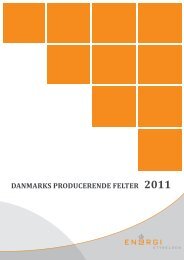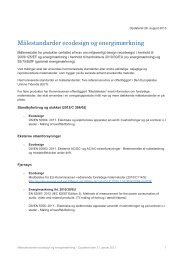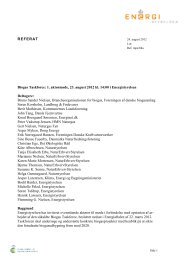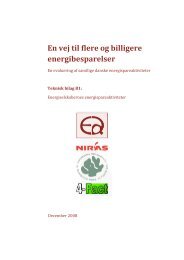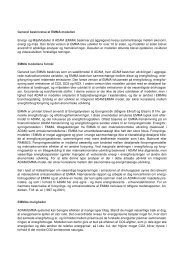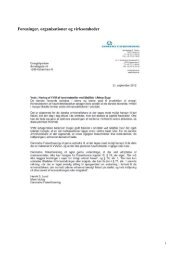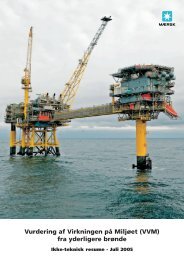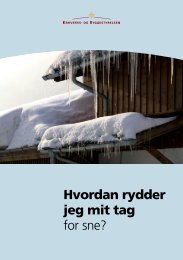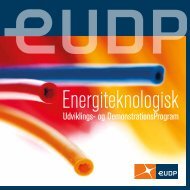Benthic Communities at Horns Rev Before, During and After Con
Benthic Communities at Horns Rev Before, During and After Con
Benthic Communities at Horns Rev Before, During and After Con
Create successful ePaper yourself
Turn your PDF publications into a flip-book with our unique Google optimized e-Paper software.
<strong>Horns</strong> <strong>Rev</strong>. <strong>Benthic</strong> communities Page 72<br />
colonis<strong>at</strong>ion of Cancer pagurus to the introduced hard substr<strong>at</strong>es was interpreted negligible<br />
impact from the piling activities on the popul<strong>at</strong>ion of Cancer pagurus. No investig<strong>at</strong>ions<br />
were made on the impacts from pile driving activities or from cable laying activities<br />
to the benthic communities.<br />
4.2.1.2. Introduction of hard bottom substr<strong>at</strong>es<br />
The most significant effect from the construction of the offshore wind farm was the loss of<br />
habit<strong>at</strong>s <strong>and</strong> the introduction of hard substr<strong>at</strong>e habit<strong>at</strong>s into a community exclusively<br />
domin<strong>at</strong>ed by infauna in s<strong>and</strong>y sediments.<br />
The fauna communities on the introduced hard substr<strong>at</strong>es are completely different from<br />
the infauna community as existed <strong>at</strong> the wind turbine sites prior to the erection of the wind<br />
turbines <strong>and</strong> the establishment of the scour protections. At the turbine sites, new habit<strong>at</strong>s<br />
were introduced th<strong>at</strong> changed the substr<strong>at</strong>es from pure s<strong>and</strong> to found<strong>at</strong>ions of steel, gravel<br />
<strong>and</strong> stones. A typical epifaunal community has replaced the n<strong>at</strong>ive infaunal community<br />
th<strong>at</strong> is characteristic of s<strong>and</strong>banks in the North Sea.<br />
<strong>During</strong> the 2003 to 2005 surveys <strong>at</strong> the introduced hard substr<strong>at</strong>es, all of the larger mobile<br />
epifaunal species previously observed were found. Except for the brown shrimp (Crangon<br />
crangon), the larger species were generally found more frequently <strong>and</strong> in higher numbers.<br />
More members found in the infauna Goniadella-Spisula community, typical for the infauna<br />
community <strong>at</strong> the <strong>Horns</strong> <strong>Rev</strong> area, were registered <strong>at</strong> the hard bottom substr<strong>at</strong>e <strong>at</strong> the<br />
turbine found<strong>at</strong>ions.<br />
The hard substr<strong>at</strong>es after construction of the wind farm were used as h<strong>at</strong>chery or nursery<br />
grounds for several species, which was an especially successful nursery for the edible crab<br />
(Cancer pagurus). The number <strong>and</strong> biomass of Cancer pagurus juveniles <strong>at</strong> the turbine<br />
sites has increased markedly from 2003 to 2005. Juveniles of the edible crab were especially<br />
found in large numbers on the monopiles in autumn with larger individuals often<br />
observed in caves <strong>and</strong> crevices among stones on the scour protection. More size classes of<br />
Cancer pagurus were found in March 2005. The growth of Cancer pagurus individuals<br />
were demonstr<strong>at</strong>ed from September 2003 to September 2005 indic<strong>at</strong>ing th<strong>at</strong> juvenile edible<br />
crabs utilise the turbine found<strong>at</strong>ions as nursery grounds. It is likely th<strong>at</strong> Cancer pagurus<br />
larvae <strong>and</strong> juveniles rapidly invade the hard substr<strong>at</strong>es from the breeding areas. Cancer<br />
pagurus females normally breed buried in s<strong>and</strong> in deeper areas of the North Sea <strong>and</strong> can<br />
be buried for months after m<strong>at</strong>ing. Juveniles settle in l<strong>at</strong>e summer/ early autumn <strong>and</strong> remain<br />
there until they reach a carapace width of 6-7 cm, which takes about 3 years, before<br />
they move to subtidal areas (Neal & Wilson, 2005). It is possible th<strong>at</strong> the juveniles in size<br />
class 2+ with carapace widths of approxim<strong>at</strong>ely 4 cm were about 2 years old <strong>at</strong> <strong>Horns</strong> <strong>Rev</strong><br />
. The average body weight of the juveniles found in the initial popul<strong>at</strong>ion in March 2003<br />
were higher than the average body weight of the juveniles found in March 2004 indic<strong>at</strong>ing<br />
th<strong>at</strong> the hard bottom substr<strong>at</strong>es were initially colonized by <strong>at</strong> least some young crabs <strong>and</strong><br />
not only by larvae. Further m<strong>at</strong>ure specimens were initially found <strong>and</strong> studies off the<br />
Dutch coast have also shown th<strong>at</strong> m<strong>at</strong>ure individuals of Cancer pagurus quickly invaded<br />
newly established artificial reefs (Leewis & Hallie, 2000).<br />
Doc. No. 2572-03-005 rev. 4




